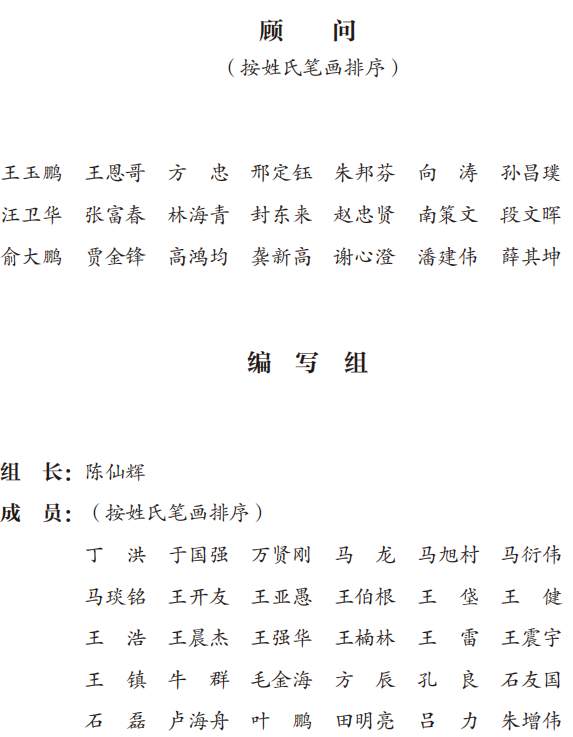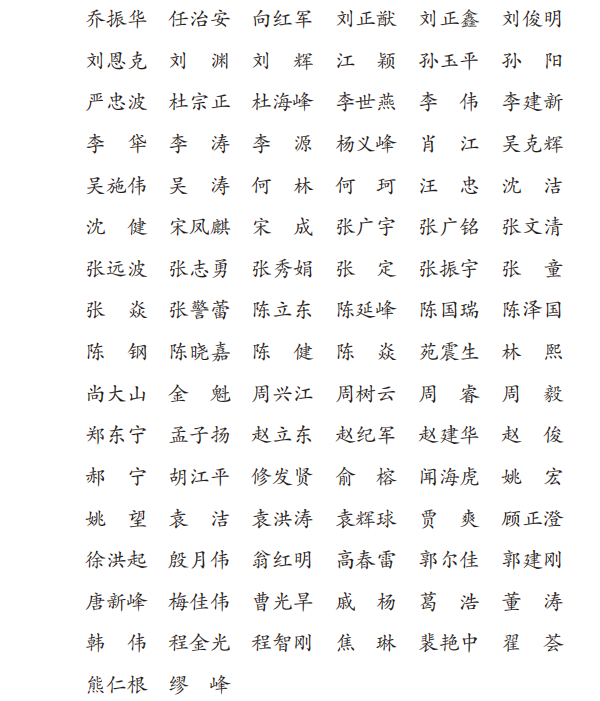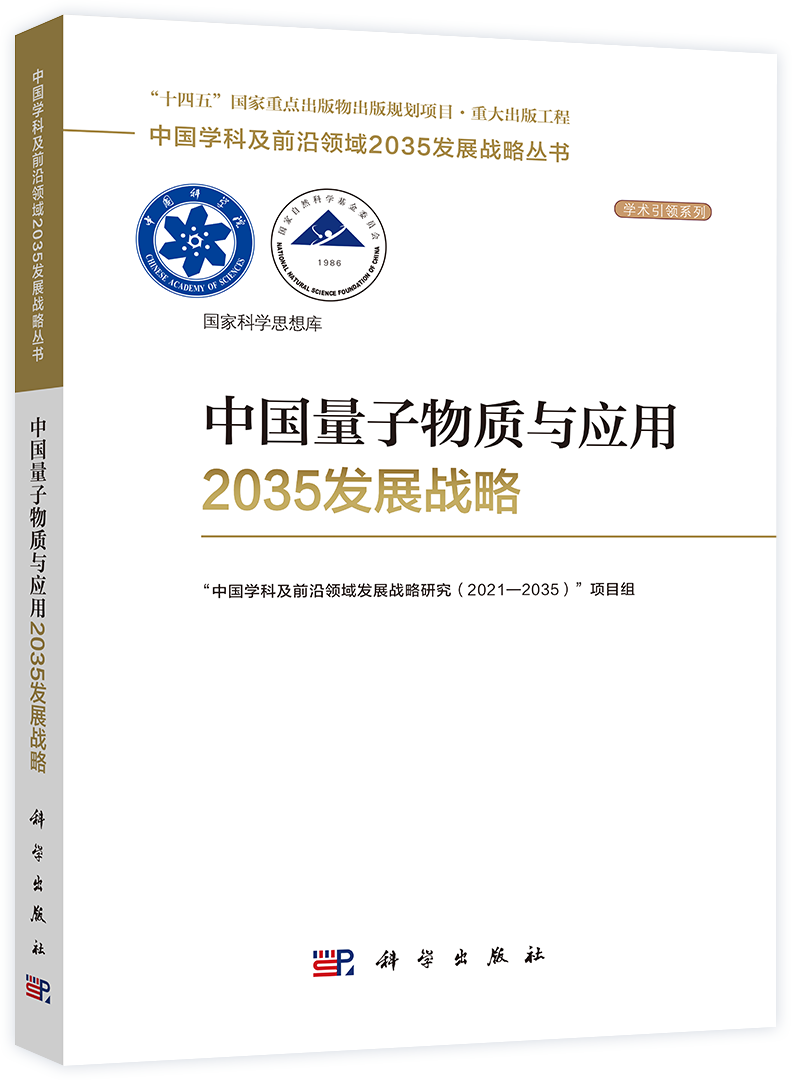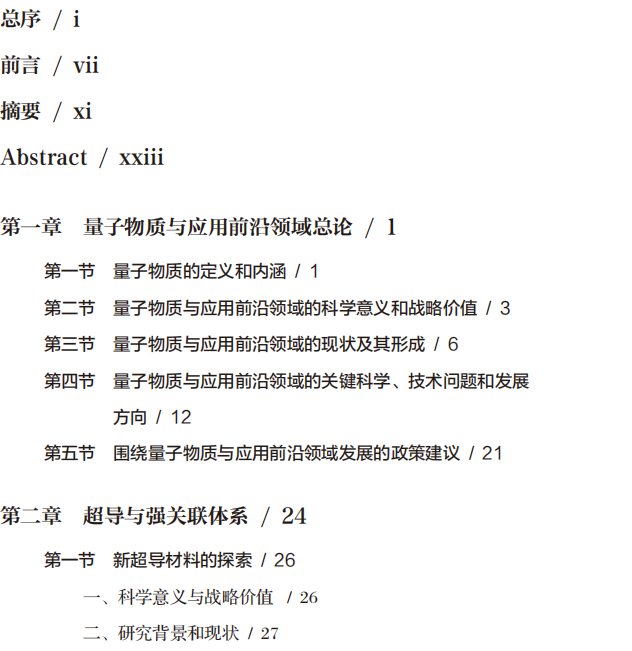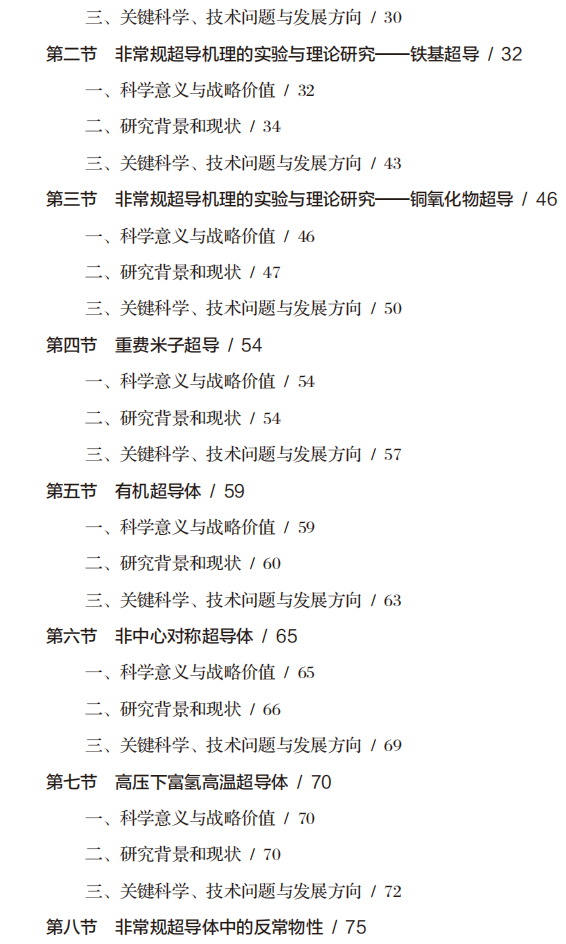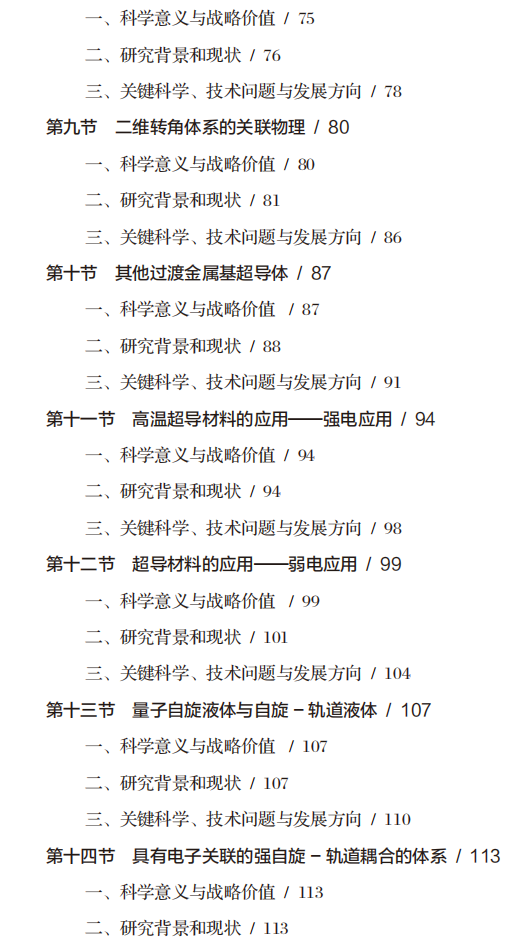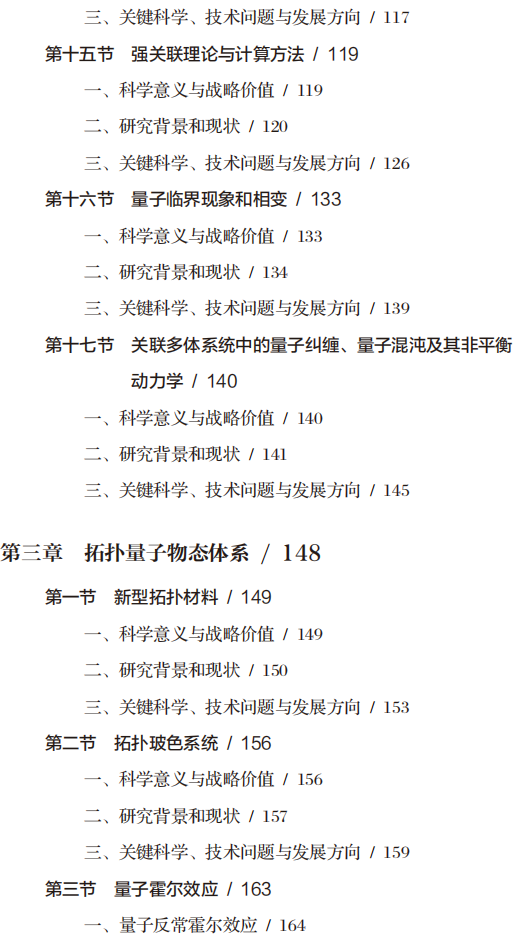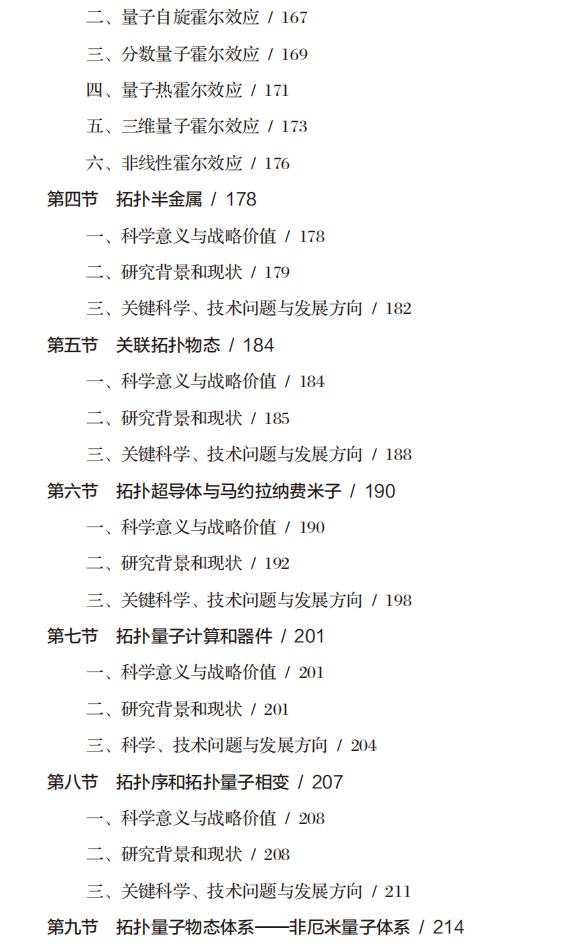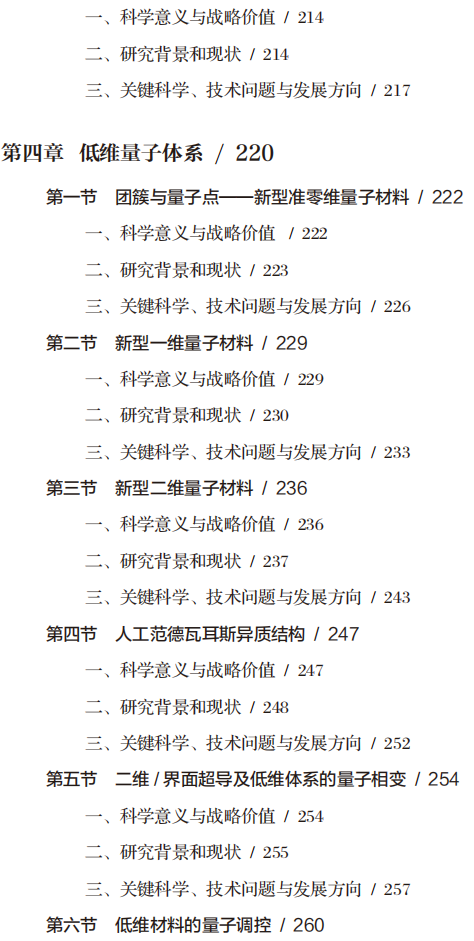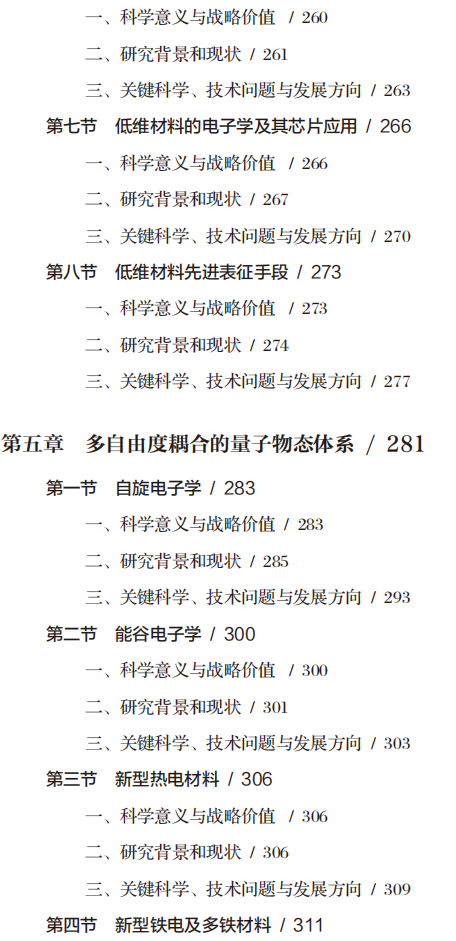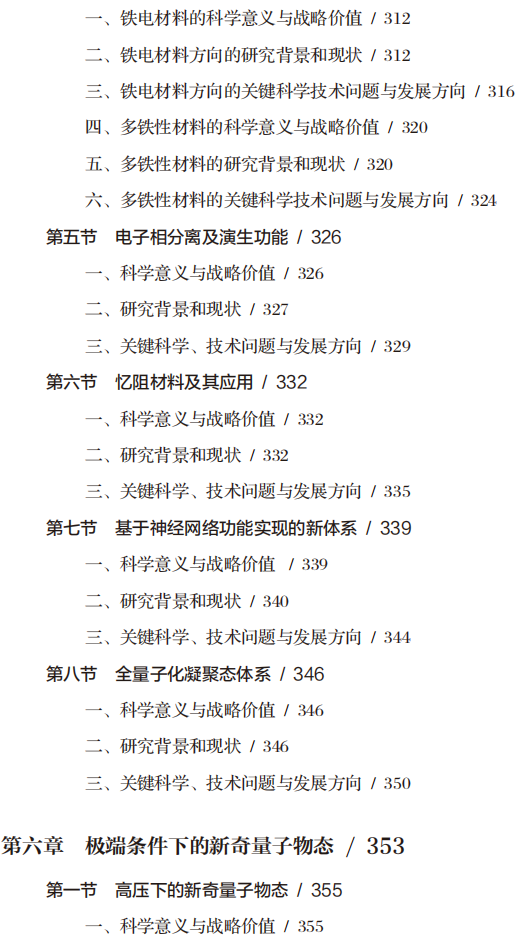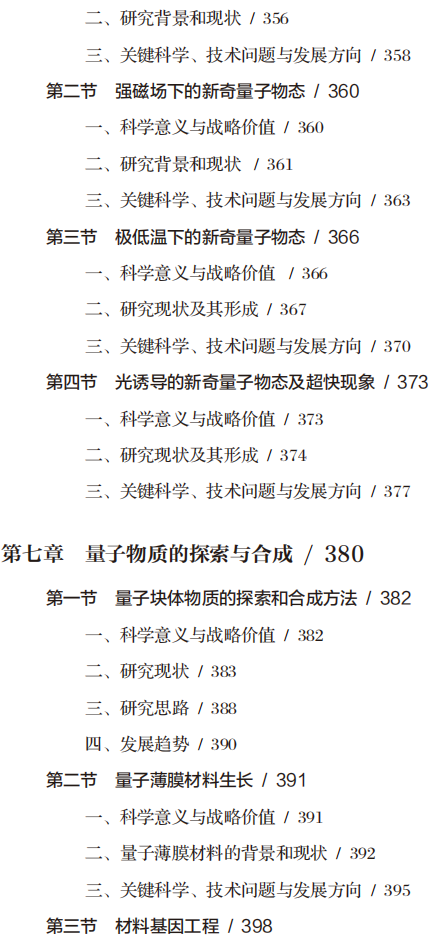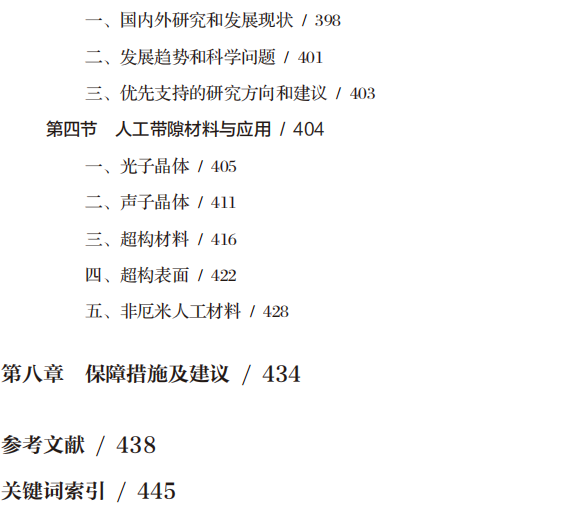认知和利用物质材料是人类文明发展的基础。量子物质前沿领域的兴起是人类对物质世界的认知深入到微观尺度的必然结果。该前沿领域起源于凝聚态物理,研究对象是由大量(微观)粒子组成的复杂物质体系的结构以及粒子的集体激发行为。量子物质领域在发展过程中与物理学的其他分支(特别是原子分子物理和光学)、化学、材料科学、信息科学、微电子学、生物学及医学等不断交叉融合,已成为物质科学的核心前沿领域。量子物质研究既是基础性的引领科学,又与应用需求密切相关。一方面,量子物质领域的研究把人们对物质世界的认识在微观尺度和复杂性这两个方向上推进到前所未有的深度,并以此指导设计新型材料结构、发现新奇物态、制备先进量子器件;另一方面,它还具有鲜明的先导特性,为高新技术和前沿科技产业的发展提供不可或缺的物质基础与原理支撑,很有可能推动下一次产业革命。量子物质和应用是一个相对新颖并快速发展的前沿研究领域,其内涵和具体研究内容在过去十年不断得到扩展。在这个时间节点编纂一部战略发展规划,在回顾和总结我国量子物质领域已取得的成就的基础上,对不同分支领域进行深入剖析,审视其发展态势,评估所面临的挑战和机遇,甄选优先发展方向,为我国相关科研工作者、各级政府和科技管理部门提供一个相对前瞻性的视角和参考,是一件有意义的工作。
一、量子物质与应用前沿领域的科学意义与战略价值
量子物质是量子力学应用于物质科学并深入发展的必然结果,极大地提升了人类对微观世界的认知,也从根本上改变了能源、信息和材料这三大现代科技支柱的原有理论框架与研发模式。顾名思义,量子物质是将量子理论运用于物质科学的研究领域,具有十分广阔的科学内涵。通过综合考虑学科发展历史规律和未来发展趋势,确定量子物质前沿领域的主要研究对象为:电子关联相互作用显著或存在某种类型电子序(如超导、磁有序)的材料体系,由于波函数的几何相位而呈现奇特电子特性的体系,以及其他宏观集体性质受量子行为控制的系统(如超冷原子体系)等。量子物质的普遍特征是大量个体单元组成的复杂体系表现出“演生”现象:对于由大量个体单元构成的复杂体系,其整体行为并不能依据单个粒子的性质做简单的外推,而是在每一个不同的复杂层次都会呈现全新的物理概念、物理定律和物理原理,其整体性质远超出个体单元的物理学规律。
量子物质前沿领域的研究不断改变着人类对物质世界的认知,推动了人们对物质中各种单粒子和集体激发基本规律的理解。基于单电子近似的固体能带理论和朗道费米液体理论在区分绝缘体、半导体、金属和解释它们的物理性质上取得了巨大的成功,促进了晶体管的发明和微电子工业的发展,推动着人类社会进入信息时代;磁性微观量子模型的建立,使人类对磁性的起源和相关物性有了深刻认识,众多新的磁性物理现象的发现(如巨磁阻效应),开辟了磁记录和高速信息读写的新方式,目前已被广泛应用于电子信息工业和日常生活中。在量子物质前沿领域中,研究对象往往存在电荷、自旋、轨道和晶格等微观自由度之间的紧密耦合,外界参量微小的变化即可导致系统在不同的量子物态之间转换从而产生巨大的物性变化。随着新物质体系的不断发现,大量新奇的演生物理现象、新的物理概念被不断揭示,如(分数)量子霍尔效应、量子自旋霍尔效应、高温超导电性、近藤效应、马约拉纳准粒子、斯格明子、量子自旋液体等,已超越了现有能带理论和朗道费米液体理论的范畴。量子物质前沿领域不断涌现的新材料、新现象和新物理,将推动人们产生全新的物理思想,促成科学上的重大变革,为信息、材料和能源领域的长久发展提供科学基础,具有重要的战略意义。
二、量子物质与应用前沿领域的发展规律和发展趋势
量子物质前沿领域的一大鲜明特点是与实际应用需求密切相关,从根本上推动技术进步和产业变革。在量子物质领域不断涌现的新物质和新现象为诸多新技术的形成奠定了原理基础作为支撑,为高新技术的发展提供了物质材料,其每一次跨越和突破都会推动若干新兴产业的发展。20世纪,沿着摩尔定律快速发展的半导体电子技术引领了全球科技、经济市场和社会生活的进步与发展。目前,半导体集成电路中器件尺寸正逼近物理极限,基于传统材料的半导体器件性能和制造工艺接近发展的瓶颈。在这样的时代背景下,如何在基础材料以及器件层面实现突破,支撑现代社会的计算需求,是当前量子物质领域的重要前沿课题。一方面,基于量子物质的低功耗信息存储、存内计算和类脑计算等迅速发展,这些新型计算架构有望更好地满足大数据、人工智能等方面的计算需求;另一方面,基于量子态叠加和纠缠的量子计算在近年来取得了很大进展,有望对人们未来的生产和生活方式产生革命性影响。量子物质领域的研究是材料科学中重大创新的先导,为能源和信息技术的长远发展提供了科学基础。例如,超导材料所展现的零电阻、完全抗磁和磁通量子化等奇特电磁性质已经在电力、医疗、通信、军事以及科学研究等领域获得了广泛的应用,在不久的将来,超导相关技术也有望在能源、交通和量子计算等领域中产生大规模应用。
近年来,量子物质领域的发展在深度和广度上表现出强劲的态势,研究的边界不断拓展,研究更加深入,研究对象更加广泛。随着研究手段的不断发展,人们能够在多种极端情况下实现新的物质结构和形态,对它们的深入研究也不断提升人们的认知水平。实验技术的发展和完善,使得人们对量子物态的研究从统计平均的宏观水平,深入到单原子的空间尺度、阿秒的时间尺度,从而揭示了大量新的量子现象。随着研究的不断深入,量子物质领域的研究对象也从早期的电子等费米子体系拓展到光子、冷原子等玻色子体系及极化子等复合准粒子体系,从三维块材扩展到量子效应显著的低维和界面体系;物态调控手段越来越多样化、协同化,通过改变压力、磁场、电场、应力、堆垛摩尔周期等多种方式实现对量子物态和性质的调控;对材料制备的控制能力不断提高,薄膜生长和异质结构筑技术使得人们有望实现“自下而上”的功能导向的原子制造技术路线,在原子尺度构造、搭建、调控量子物质体系,进而直接制造功能器件。
随着量子物质研究的不断深入,人们所探索的物质系统越来越复杂,仅靠实验观测来总结物质世界的演化会有很大局限性,因此理论、计算和实验观测的结合越来越紧密。量子多体系统的数值计算方法在关联物态的研究过程中获得了长足的发展,大量新的数值算法被提出,如新型量子蒙特卡罗方法、动力学平均场方法、密度矩阵重正化群方法、各种类型的团簇近似方法等,使得人们计算处理复杂物质系统的能力不断提升。建立一个超越朗道框架的普适的低能有效理论图像不仅是量子物质领域研究自身的需要,也是其基础研究价值最重要的体现方式。这一目标的达成需要来自实验、理论、计算研究的长期密切合作。这种新研究范式的建立,必将使相关基础科学和应用研究迈上一个新的历史台阶。
在量子物质领域的研究中,尖端精密测量技术和大科学装置发挥着越来越重要的作用。物质科学的发展历史表明,关键表征技术的进步能极大地促进人们对物质材料的科学认识和应用。先进表征技术的发展本身也带来了众多应用技术的进步,如实验表征通常对物质表面的洁净程度有非常高的要求,为此发展出超高、极高真空技术;很多奇异物性在低温甚至极低温才会出现,因而发展出低温和极低温制冷技术;对材料性质进行测量时通常需要外部磁场调控,因此催生出稳态强磁场和脉冲强磁场技术。可以说,国际上前沿物质科学研究的竞争,在很大程度上取决于能否掌握和研发出领先的、创新性的表征技术,而先进表征技术的突破又能推动尖端应用科学技术的发展。同时,大科学装置是开展战略性、基础性和前瞻性科学研究的基础,是实现高水平的科技突破和集成创新的重要支撑,为提升国家原始创新能力、完善专业人才队伍建设、加强国际交流合作、带动高新产业发展起到巨大的促进作用。在量子物质研究领域,同步辐射光源、中子源以及稳态和脉冲强磁场等大科学装置作为重要的支撑平台,极大地提高了探索和研究量子物态的能力。
我国在量子物质的各分支领域都有布局并且进行了长期的支持,在研究队伍规模、测量设备条件、理论认知深度等方面都已具备较强的国际竞争力。目前,我国在量子物质的主要分支上已形成较大的覆盖面,在许多领域也取得了受国际同行广泛关注的研究成果,有些方向甚至走到国际最前沿,在一段时间内引领学科的发展。近十多年来,我国在量子物质领域中取得了一系列国际瞩目的研究成果,代表性工作包括铁基高温超导、量子反常霍尔效应、外尔半金属、拓扑材料数据库以及新型二维材料的发现等。在量子物质的应用研究中,我国研制了10 kV/2.5 kA和35 kV/2.2 kA三相同轴交流高温超导电缆,已将超导电缆分别运用于深圳和上海高负荷密度供电区域,系全球首次城市核心区域实用化应用;我国在自主研制二维结构超导量子比特芯片的基础上,成功构建了包含62个比特的可编程超导量子计算原型机“祖冲之号”,实现了量子优越性并为后续研究具有重大实用价值的量子计算打下了基础。
总体来说,在量子物质与应用前沿领域,我国已实现了研究“量”的突破,并在一些分支领域做出了引领性的工作,但还没有实现主流方向上的大面积领先,标志性的原创工作还不显著。这主要表现在深层次、长周期的系统性研究工作不多,独立发现的新物质体系、发现新现象和新规律的原创性工作较少;理论计算和实验测量在总体上的相互合作不够充分;自主研发新颖实验技术、开发新的计算方法的能力仍待加强;较为注重材料工艺和简单表征研究,缺乏研究上游新概念、新理论的工作;基础研究的下游—实际应用之路还较为狭窄。下一步发展需要在原创性上下功夫,实现更多“质”的突破,建设量子物质与应用前沿领域的科技强国。未来,应加强领域总体规划,完善宏观布局,逐渐减少一些重复性的研究,鼓励深层次、长期系统的原创性研究;充分发挥大科学装置的作用,完善专业人才队伍建设;鼓励发展新的计算方法和软件、自主研发尖端实验设备,提高开创性研究的能力。
三、量子物质与应用前沿领域的关键科学问题、发展思路和重要研究方向
量子物质和应用前沿领域立足于对物质微观世界中基本规律的探索,着眼于先进功能材料、量子现象和器件的实际应用,是一个基础性和应用性都很强的科学领域。目前,国际上量子物质领域总体仍处于基础研究全面开展和产业应用的培育阶段,未来十年是有望实现多点突破的关键时期。在未来布局上需要追求在应用导向研究和长远探索性研究之间保持均衡发展,既要强调对新物理、新现象、新材料和新物态调控手段的探索,也要重视发挥其在材料、信息、能源等领域的引领作用,使科学研究成为推动社会经济发展的原动力。在研究方向的选择上,统筹兼顾自由探索和国家战略导向性研究,优化研究队伍的组织架构。
根据自身物理规律的特质以及与不同应用领域的融合情况,可将量子物质与应用前沿领域分为超导与强关联体系、拓扑量子物态体系、低维量子体系、多自由度耦合的量子物态体系、极端条件下的新奇量子物态以及量子物质的探索与合成六个分支方向。布局应在总体统筹的情况下各有侧重,既要保持分支领域的研究特点,又要促进分支之间的交叉融合,推动我国量子物质领域的快速、可持续发展。
超导与强关联体系中最重要的科学问题包括高超导转变温度乃至室温超导的实现、对高温超导机理的理解以及超导材料的低成本和大规模应用。如果电子具有强的配对势,同时晶格还不失稳,就有可能获得更高转变温度的超导。从理论上讲,除了电声子耦合图像之外,还存在一种预期,即利用电子系统自身的强关联效应来实现高温下的超导配对。在强关联图像下,这些强配对势的库珀对如何形成,如何理解伴随超导出现反常物性,是高温超导机理研究的重点内容。建立一个超越朗道框架的普适的低能有效理论图像不仅是高温超导机理研究自身的需要,而且也能促成物理学的重大突破。为此,还有必要发展多体数值计算方法以得到强关联系统准确的基态、激发态和相变等关键信息。在超导应用方面,一方面需要提高高温超导材料的综合性能,使其性价比优于传统的导电材料,实现低温制冷系统长期运行的可靠性和稳定性。另一方面,超导集成电路、新材料电子技术、量子技术新原理等也会成为电子信息技术领域的前沿和国际竞争热点。其中超导量子计算在过去二十多年发展迅速,已经从最初的展示宏观电路量子特性的基础研究,发展成一个有可能孕育出变革性新技术的研究方向。
拓扑材料的高通量计算和非磁性拓扑电子材料数据库的建立,使得拓扑材料的分类和预测工作已经基本完成。拓扑量子物态领域的下一步研究目标是预测、发现、调控新型拓扑材料和拓扑量子物态。“新”可以体现在以下几个方面。①与已发现的材料相比,物理性质更为理想的拓扑绝缘体和拓扑半金属材料,为拓扑电子学器件发展提供材料基础。②与磁性、超导电性等效应共存的拓扑物态和其对应的材料。它们不仅是值得深入探索的新颖物态,也是拓扑物理走向应用的一个重要出口。例如,磁性拓扑材料有望成为拓扑自旋电子学、拓扑电路互连、高温量子反常霍尔效应等物理效应的理想载体,在信息传感、信息传输、逻辑运算、高密度存储和催化等方面具有巨大的应用潜力;拓扑超导作为马约拉纳准粒子的载体,有望用以发展拓扑量子计算。③打破了传统的“体边对应原理”的新型拓扑量子物态,如高阶拓扑物态、非厄米拓扑体系等。在此基础上,利用新奇的拓扑物性,即无耗散的电荷、自旋输运,具有全局稳定的高容错性,非局域电、磁、光、热调控等,可用于拓扑量子计算的马约拉纳零能态等,来推动原型拓扑器件的探索。同时,光和声是除电子之外另外两个信息载体和媒介,在信息的产生、传播、处理和显示中具有不可取代的作用。与之对应的拓扑玻色体系的性质具有鲁棒性,有望发展适于光波、声波调控的新应用和新器件。
低维量子体系的研究总体仍处于基础研究阶段,部分材料体系正迈向产业应用的培育阶段。结合国家需求和领域发展前景,低维量子体系的研究目前在以下四个方向上蕴含大量原创性发现的机会。①新型低维量子体系的创制,以及多种低维量子物态的复合。②低维量子体系的物态调控,以及基于低维量子体系物态调控的器件原型研发。③低维量子材料的大规模制备及其产业化应用。④低维量子体系先进表征手段的研发及其国产化。基础研究首先要扩大低维材料的研究范围,预测、制备更多的新型材料,并通过在单原子、单电子、单自旋水平上的结构与性能表征,更深入理解新奇物性的起源,从而进行精准的调控。在此基础上探索二维量子材料在面向未来的信息功能器件中的应用,发展和半导体工艺兼容的相关技术和工艺,研发高灵敏度、高速、低功耗的自旋逻辑器件和存储器件。同时,需要开发有效的样品生长与转移技术,实现高质量、大面积低维材料的制备和转移加工;鼓励对科研设备的自主研发,加强前沿实验技术与企业间的合作,对通用的核心实验技术和有应用前景的前沿表征技术进行推广。
立足固体中电子与相关物理自由度间的关联,结合国家需求和领域发展前景,多自由度耦合量子物态体系应优先布局发展的方向如下。①自旋电子学,着重发展与半导体微电子工艺兼容的超高密度、大容量、非易失磁存储和逻辑存算一体化器件等;②新型热电材料,发展新概念、新方法协同调控电子声子输运,研发热管理和能量转换一体化的新概念器件;③铁电和多铁材料,关注量子理论的发展和多功能设计,推动智能材料与器件、电控磁性存储和新型铁电量子器件的研发;④忆阻材料,促进存算一体神经形态、模拟、数字逻辑、随机计算等超越传统冯 诺依曼架构的研究探索。多自由度耦合的量子物态,常伴随着热力学相空间多个能量极小值出现,空间上的电子相分离难以避免。研究电子相分离的基本规律和演生效应不仅具有重要的基础科学价值,而且将指导开发更多的新型功能器件。为克服当前存算分离计算框架的困难,发展基于高性能量子材料的类脑计算、存算一体化和深度学习功能的神经网络体系也被寄予很高期望。
极端实验条件是已知与未知之间的边界。极端条件下对新奇量子物态的探索虽然难度大、周期长,但却是一个明确可行、有望获得未知物理现象的研究方向。极端条件下对新奇量子物态的研究已经体现出明确的价值,并针对部分关键科学问题形成了较为集中的研究方向。磁场下的物态调控随着强磁场装置的发展成为量子物质领域的重要研究方向。在强场激光和超快光学领域也有一系列前沿热点问题(如光诱导的高温超导电性、光诱导的超快相变和调控、强场激光对磁性材料的调控、强场激光对拓扑材料的调控、强光场和微纳结构的强耦合效应等)。超冷原子(分子)系统可以用来模拟复杂的量子多体模型并用显微学的方法研究其物理性质,理解凝聚态物理和量子场论中悬而未决的物理问题,并为精密测量和量子计算等领域提供高精度的量子测控技术。多种不同极端条件的结合也为对现有科学问题的深入理解提供了有价值、有潜力的研究方法。在极端条件下量子物质的研究中,尖端仪器的创新以及大科学装置的应用扮演着重要角色。
新型量子材料的探索与合成往往是量子物质领域研究的突破口,并对相关科学技术起到决定性作用。如何在无机化合物晶体结构数据库中寻找有科学价值的量子材料,确定哪些元素可以组成尚未被发现的量子材料,是量子物质领域的根本问题之一。材料基因组是材料研发的最新理念,其通过高通量计算缩小尝试范围,利用并行和组合思想的方法加速实验流程,借助机器学习寻找海量数据库中潜藏的规律,并回过头来修正理论模型,指导材料设计。新颖异质界面的构筑、基于电子能带的多物态调控、微纳尺度的低功耗优性能器件以及人工带隙材料等也是未来需要重点发展的方向。近年来,人们在以转角石墨烯为代表的摩尔超晶格体系中陆续实现了多种新颖的量子物态,转角调控也成为量子物态人工调控的新的有效手段。
四、围绕量子物质与应用前沿领域发展的政策建议
综合量子物质领域的研究特点、发展现状和国家需求,为保障未来十五年我国该领域的持续发展并进入世界前列,提出如下建议。①建立更活跃的跨学科交流网络,鼓励国内不同研究小组之间的深入合作,组建具有不同学科背景的联合攻关团队,明确适合跨学科合作模式下符合时代发展的成果贡献体现形式和考核评价机制,鼓励研究人员围绕重大基础问题开展长期、深入的合作。②在基础研究和应用开发中,应鼓励和坚持走自主创新的道路,在科研经费方面给予长期稳定支持,提高科研经费的分配和使用效率,通过政策倾斜鼓励有条件的企业投资或自主展开基础科研。③重视人才队伍的结构化培养,重视基础教育,优化学科的课程教育体系,建立技术人员的支持和晋升机制。④深化企业、科研院所和高校之间的合作,注重前沿基础研究与产业界的联系,提高技术创新能力和创新技术的产品转化。⑤鼓励科研设备的自主研发,开展多种类的仪器研制项目。⑥在新的国际环境下,应加强国际学术交流和合作,建立新的交流和合作途径及模式。
Abstract
The cognition and utilization of materials constitute the foundationfor the development of human civilization. The rise of quantum matter is an inevitable result of human cognition of materials to the microscale. In this frontier, which originates from condensed-matter physics, the structures of complex material systems comprising many (micro) particles and the basic law of collective excitation behavior of these particles are adopted as research objects. Notably, the feld of quantum matter continuously overlaps with other branches of physics (particularly the atomic and molecular physics and optics), chemistry, material science, information science, microelectronics, biology, and medicine, and it has become the frontier feld of material science. Quantum matter research is a basic leading science that proffers solutions to practical application-based needs. On the one hand, the study of quantum matter expands our understanding of materials to an unprecedented level in the directions of both complexity and microscopic scale, naturally guiding the design of new material structures, discovery of novel states of matter, and fabrication of advanced quantum devices. On the other hand, due to its distinctive leading characteristics, this research field presents indispensable material foundation and principle support for developing highly advanced and cutting-edge science and technology industries, and it is expected to play a leading role in the next industrial revolution. As a relatively new research frontier, quantum matter and its applications are developing rapidly, and its connotation and specifc research content have expanded in the past decade. Therefore, it is meaningful to compile a strategic development plan for reviewing and summarizing the progress in the feld of quantum matter in China, which encompasses an in-depth analysis of different subfields, examination of their development trend, evaluation of the challenges and opportunities faced, and determination of high-priority development directions. Additionally, forward-looking perspectives and reference for relevant scientifc researchers, governments at all levels, and science and technology management departments in China are provided.
0.1 Scientifc signifcance and strategic value of the frontier feld of quantum matter and its application
Quantum matter, as the name implies, involves applying quantum mechanics to material science. The emergence of quantum matter not only significantly improves our cognition of the micro-world, but also fundamentally changes the original theoretical framework and research and development (R&D) mode of the three modern scientific and technological pillars: energy, information, and materials. With applying quantum theory to material science, the scientifc connotation of quantum matter is considerably broad. Based on the careful consideration of the discipline’s historical development law and future development trends, the main research objects of quantum matter include material systems with signifcant electronic-correlation interaction or some types of electronic orders (such as superconductivity and magnetic order), systems exhibiting peculiar electronic characteristics because of the geometric phase of the wave function, and other systems (e.g., ultracold atomic systems) whose macroscopic collective properties are controlled by quantum behaviors. A universal feature of quantum matter is that complex systems composed of many individual units show “emergent” phenomena, i.e., the overall behavior of a complex system composed of many individual units cannot be simply extrapolated based on the properties of individual particles. Instead, at different complex levels, new physical concepts, laws, and principles emerge, and the overall properties are far beyond the physical laws of individual units.
The research on the frontier filed of quantum matter constantly changes our cognition of the material world and promotes our understanding of individual particles and the various basic laws of collective excitation in materials. Using the band theory of solids based on single-electron approximation and Landau’s Fermi-liquid theory, researchers have achieved significant success in distinguishing insulators, semiconductors, and metals, in addition to explaining their physical properties. These achievements have facilitated the invention of transistors and the development of the microelectronic industry, launching human society into the information age. With the establishment of the microscopic quantum theory of magnetism, humans obtained a deep understanding of the origin of magnetism and its related physical properties. Many new magnetic phenomena have been discovered, such as the giant magnetoresistance , which has facilitated the development of magnetic recording and high-speed information reading and writing. Today, these phenomena are widely utilized in the electronic information industry and our daily life. In the frontier field of quantum-matter, there are often close couplings among micro degrees of freedom, such as charge, spin, orbit, and crystalline lattice, in the research objects. Slight changes in external stimuli may lead to phase transitions between diferent quantum states, resulting in signifcant changes in the physical properties. The continuous discovery of new material systems has led to the continuous discovery of many novel and evolutionary physical phenomena, as well as new physical concepts, such as the (fractional) quantum Hall effect, quantum spin Hall effect, high-temperature superconductivity, Kondo effect, Majorana quasiparticle, Skyrmion, and quantum spin liquid, which are beyond the scope of the existing band theory and Landau’s Fermi-liquid theory. The emergence of new materials, new phenomena, and new physics in the frontier of quantum matter, will inspire breakthrough in physical understanding, promote major changes in science, and provide a scientifc basis for the long-term development in the felds of information, materials, and energy. Thus, the feld of quantum matter is of high strategic signifcance.
0.2 Development law and development trend in the frontier feld of quantum matter and its application
A distinctive feature of the frontier field of quantum matter is its close relation to practical application-based needs. Thus, this field fundamentally promotes technological progress and industrial transformation. The new materials and new phenomena emerging in the field of quantum matter provide theoretical support for developing various new technologies and materials for the development of new and high technologies. Each leap and breakthrough will facilitate the emergence of several emerging industries. In the last century, the rapid development of semiconductor electronic technology following Moore’s law led to the progress and development of science and technology, the economic market, and social standards worldwide. Today, the size of devices in semiconductor-integrated circuits is approaching the physical limit, and the performance of and manufacturing engineering for semiconductor devices based on traditional materials are approaching the limit. In this background , low-power information storage, in-memory computing, and neuromorphic computing based on the quantum matter are developing rapidly, and these new computing architectures are expected to better meet the computing needs of big data and artificial intelligence. Moreover, the research on quantum computing based on quantum superposition and entanglement has recorded significant progress in recent years, and this feld is expected to have a revolutionary impact on our production and lifestyle in the future. The research in the field of quantum matter plays a leading role in achieving major innovation in material science, providing a scientifc basis for the long-
term development of energy and information technology. For example, the peculiar electromagnetic properties of superconducting materials, such as zero resistance, Meissner efect, and fux quantization, have been widely exploited in electric power, medical treatment, communication, military, and scientifc research applications. In the near future, the large-scale application of superconductivity-related technologies is anticipated in energy, transportation, and quantum computing felds.
In recent years, the development of the quantum matter field has shown a strong trend in depth and breadth. The research boundaries are constantly expanded, and the research objects are becoming more in-depth and extensive. The continuous advancement in this frontier will enable the achievement of new material structures and forms in various extreme situations. Meanwhile, the in-depth study of these new material structures and forms will also broaden our cognitive level constantly. The development and improvement of experimental techniques will promote the in-depth research of quantum states from the macro level of statistical average to the spatial scale of single atoms and the time scale of attosecond, thus enabling the emergence of numerous quantum phenomena. With the research advancement, the research objects in the feld of quantum matter have also expanded from fermion systems, such as electrons in the early stage, to bosonic systems such as photons and cold atoms, as well as composite quasiparticle systems. The research objects have also expanded from three-dimensional bulk materials to low-dimensional and interface systems with signifcant quantum efects. The diversity and synergy of the means of phase manipulation are improving, and the quantum state and properties can be regulated by adjusting the pressure, magnetic field, electric field, strain, moir stacking, etc. The control of material-synthesis procedures is continuously improving. Film growth and heterostructure engineering enable the achievement of “bottom-up” function-oriented atomic manufacturing technologies, as well as the construction, building, and manipulation of quantum matter systems at the atomic scale to directly manufacture functional devices.
With the advancement in quantum matter research, the complexity of material systems is increasing, and the evolution of the material world based only on experimental observation will be met with significant limitations. Therefore, the efficient combination of theory, calculation, and experimental observation is strongly desired. The research on correlated states of matter has facilitated the advancement of the research on the numerical calculation method of the quantum many-body system, with many new numerical algorithms being proposed, such as the new quantum Monte-Carlo method, dynamic mean field method theory, density matrix renormalization group method, and various types of cluster approximation methods, which continuously improve our ability to calculate and manage complex material systems. The establishment of a universal low-energy effective model beyond Landau’s framework is not only the objective of quantum matter research, but also the most important embodiment of its basic research value. In the feld of quantum matter, , the role of cutting-edge precision-measurement technology and large-scale scientific facilities is becoming increasingly important. The development history of material science shows that the advancements in key characterization technology can significantly promote our understanding of scientifc principles and the application of materials. The international competition in cutting-edge material science research, as it were, largely depends on whether leading and innovative characterization technologies can be developed and mastered, and breakthroughs in advanced characterization technologies can promote the development of cutting-edge applied science and technology. Preferably, large-scale scientific facilities are the basis for strategic, basic, and forward-looking scientific research, and they provide important support for the realization of high-level scientific and technological breakthroughs and integrated innovation. Furthermore, they play a signifcant catalytic role in promoting the original innovation abilities of countries, improving the building of professional talent team, strengthening international exchange and cooperation, and driving the development of high-tech industries. As important supporting platforms in the field of quantum matter, synchrotron radiation light sources, neutron sources, static/pulsed strong magnetic fields, and other large-scale scientific facilities significantly promote the exploration and study of quantum states.
China has created strategic plans to research various branches of quantum matter and has provided long-term support, and it has reached the global standard in terms of research team size, measurement equipment conditions, theoretical cognition depth, and so on. Thus far, China has achieved extensive coverage of the major branches of quantum matter and has recorded research achievements that have attracted consielerable attention from international peers in many felds. In some branches, it has even reached the global forefront, playing a leading role in discipline development for a period. Over the last ten years, a series of internationally remarkable research achievements have been recorded by China in the field of quantum matter. The representative work includes iron-based high temperature superconductivity, quantum anomalous Hall efect, Weyl semimetal, topological material databases, and the discovery of two-dimensional materials. In the application feld of quantum matter, China has developed 10kV/2.5kA and 35kV/2.2kA three-phase coaxial high-temperature superconducting cables, which have been employed in high-load-density power-supply areas in Shenzhen and Shanghai, respectively. These are the frst practical application in urban core areas globally. China has successfully built a 62-bit programmable superconducting quantum computing prototype, “Zu Chongzhi”, based on its self-developed two- dimensional superconducting quantum bit chip, which has realized quantum superiority and has laid a foundation for the research on quantum computing with signifcant practical value.
Generally, China has made breakthroughs in the “quantity” of research in the frontier field of quantum matter and application, and has played a leading role in some branch fields. However, it has not yet established a large-scale leading edge in the mainstream directions and is not prominent enough in iconic original works. This is mainly attributed to the following. There are not many deep-seated and long-term systematic research works, and original works on the independent discovery of new material systems, phenomena, and laws are lacking. The collaboration between theoretical calculation and experimental observation is insufficient. The ability to independently develop novel experimental technologies and new computing methods still requires improvement. The study of material technology and simple characterization are prioritized, while upstream new concepts and new theories are underemphasized. China focuses on the basic research of laboratory applications, whereas downstream practical applications are relatively trivialized. The next step in development requires effort in originality to achieve more breakthroughs, and to build a scientifc and technological powerhouse in the frontier feld of quantum materials and applications. In the next ffteen years, we should strengthen the overall planning of the feld, improve the macro layout, gradually reduce some repetitive research, encourage deep, long-term and systematic original research; fully function the large scientific facilities, and improve the construction of professional talent teams; encourage the development of new computing methods and software, independently develop cutting-edge experimental equipment, and enhance the ability to conduct pioneering research.
0.3 Key scientifc issues, development ideas, and important research directions in the frontier feld of quantum matter and application
Established for exploring the basic laws in the “micro” world of matter, the quantum matter and application frontier focuses on the practical application of advanced functional materials, quantum phenomena, and devices. This scientific field is strong in terms of foundation and applicability. To date, the global study of quantum matter is still in the stage of comprehensive development of basic research and cultivation of industrial applications; multiple breakthroughs are expected in the coming decade. When planning for the future, it is necessary to pursue a balance between application-oriented research and long-term exploratory research. We should emphasize not only the exploration of new physics, new phenomena, new materials, and new state regulation means, but also the leading role of this frontier in the felds of materials, information, and energy, so that the fundamental research can become one of the driving forces in the economic and social development. In the choice of research directions, we should strive to achieve an overall balance between free exploration and national strategy-oriented research while optimizing the organizational structure of the research team.
According to the characteristics of its physical laws and the integration with different application fields, the quantum matter and application frontier can be divided into six branches: superconductivity and strong-correlation systems, topological quantum matter systems, low-dimension quantum systems, strongly-coupled quantum systems with multiple degrees of freedom, novel quantum state of matter under extreme conditions, and quantum matter exploration and synthesis. The overall plan should have different emphases, which should not only maintain the research characteristics of the branches but also promote the cross integration among branches and the rapid and sustainable development of the quantum matter feld in China.
The most important scientific directions in the fields of superconductivity and strong-correlation systems includes the realization of a high superconducting transition temperature and even roomtemperature superconductivity, the mechanism of high-temperature superconductivity, and the low-cost and large-scale applications of superconducting materials. If the electrons have a strong superconducting pairing potential and the lattice is not unstable, it is possible to achieve superconductivity with higher critical temperature. Exploring the formation of Cooper pairs with a strong pairing potential within strong-correlation picture and understanding the abnormal physical properties accompanying superconductivity are the key contents of the research on the high-temperature superconducting mechanism. The establishment of a universal low-energy efective theory that goes beyond the Landau framework is not only a request for the study of high-temperature superconductivity, but also leads to a major breakthrough in physics. For this reason, it is necessary to develop many-body numerical calculation methods to obtain accurate, key information of ground states, excited states, and phase transitions in strongly correlated systems. In terms of superconducting applications, on the one hand, it is necessary to enhance the cost-performance ratio of high-temperature superconductors to achieve a value close to that of traditional electric conducting materials and realize the reliability and stability of long-term operation of low-temperature refrigeration systems. On the other hand, superconducting integrated circuits, new material electronic technology, and new principles of quantum technology will also become the frontiers and international competition hotspots in the feld of electronic information technology. Among them, superconducting quantum computing has developed rapidly in the past two decades, from the initial basic research to understand the quantum characteristics of macro circuits to a research stage that may breed new transformative technologies.
With the establishment of high-throughput calculation methods for topological materials and non-magnetic topological electronic material databases, the classifcation and prediction of topological materials have been basically achieved. The prediction, discovery, and regulation of new topological materials and topological quantum states have become the new research objectives in the field of topological quantum states. “New” can be reflected in the following aspects. The first is that the hunting for topological insulators and topological semimetals with more ideal physical properties compared to the existing materials that can provide a material basis for the development of topological electronics devices. The second is that topological materials coexisting with magnetism and superconductivity. They not only provide platforms to realize novel quantum states worth deeply exploring, but also presents an important outlet for the application of topological physics. For example, magnetic topological materials are expected to become ideal platform for physical effects such as topological spintronics, topological circuit interconnection, high-temperature quantum anomalous Hall effect, and have enormous application potential in information sensing, information transmission, logic operations, high-density storage, and catalysis. Topological superconductors, as the carrier of Majorana quasi-particles, are expected to be used to develop topological quantum computing. The third is that new topological quantum states that break the traditional “bulk-boundary correspondence”, such as higher-order topological states and non-Hermitian topological systems. Exploiting the novel topological properties, namely non-dissipative charge and spin transport, globally stable high fault tolerance, and non-local electrical, magnetic, optical, and thermal regulation, Majorana zero mode for topological quantum computing, can promote the exploration of prototype topological devices. Conversely, light and sound are two other information carriers and media besides electrons, which play irreplaceable roles in the generation, transmission, processing, and display of information. The corresponding topological Bosonic system is robust, and new applications and devices suitable for the regulation of light and sound waves are expected to be developed.
Generally, the research on low-dimensional quantum systems is still in the basic research stage, with material system research approaching the cultivation stage for industrial application. Taking together the national needs and feld development prospects, currently, there are huge opportunities for original discovery in the following four directions of the feld of low-dimensional quantum systems: (1) the discovery of new low-dimensional quantum systems and the recombination of multiple low-dimensional quantum states; (2) phase manipulation of low-dimensional quantum systems, and the research and development of primitive device based on the regulation of low-dimensional quantum systems type; (3) large-scale preparation of low-dimensional quantum materials and their industrial application; (4) advanced characterization methods for low-dimensional quantum systems and its localization. We should aim to frst expand the research scope of low-dimensional materials, and predict and prepare more new materials. Thereafter, through the structure and performance characterization at the single-atom, single-electron, and single-spin levels, the research eforts can be devoted to understanding the origin of the novel physical properties and achieving accurate regulation. Thus, research works should focus on exploring the application of two- dimensional quantum materials in future-oriented information functional devices; developing relevant technologies and techniques compatible with semiconductor processes; and realizing high-sensitivity, high-speed, and low-power spin logic devices and memory devices. Meanwhile, it is necessary to develop efective sample growth and transfer technologies to realize the preparation and transfer processing of high-quality and large-area low-dimensional materials; encourage the independent research and development of scientifc research equipment, strengthen the cooperation between cutting-edge experimental technologies and enterprises, and promote common core experimental technologies and promising cutting-edge characterization technologies.
In strongly-coupled quantum systems with multi-degrees of freedom, according to the national demand and field development prospects, the following research fields should be prioritized for fields: spintronics, focusing on the development of ultrahigh-density, large-capacity, non-volatile magnetic storage and logic in-memory-computing devices compatible with semiconductor microelectronic technologies; new thermoelectric materials, focusing on developing new concepts and new methods to coordinate and control electron-phonon transport and new concept devices integrating thermal management and energy conversion; ferroelectric and multiferroic materials, focusing on the development of quantum theory and multifunctional design, as well as the promotion of the R&D of intelligent materials and devices, electrically controlled magnetic storage, and new types of ferroelectric quantum devices; and memristor materials, promoting the research and exploration of in- memory-computing neural morphology, simulation, digital logic, stochastic computing, and so on, beyond the traditional von Neumann architecture. Strongly-coupled quantum systems with multi-degrees of freedom are often accompanied by multiple energy minimum in the thermodynamic phase space, and spatial phase separation is difficult to avoid. The study of basic laws and evolutionary effects of phase separation not only has important basic scientific value, but also guides the development of more new functional devices. To overcome the difculties of the separation of storage and calculation in the current framework, research efforts should be devoted to the development of neural-network systems with brain-like computing capabilities, in-memory-computing capabilities, and deep-learning functions based on high-performance quantum materials.
Extreme experimental conditions constitute the boundary between the known and the unknown. Although the exploration of novel quantum states under extreme conditions is difficult and time-intensive, it is defnitely a feasible research direction that is expected to provide insights into unknown physical phenomena. Clear results have been obtained in the research on novel quantum states under extreme conditions, and a relatively concentrated research direction has been established targeting some key scientifc problems. With the development of strong magnetic feld scientifc facility, the regulation of the state of matter using magnetic feld has become an important research direction in the frontier feld of quantum matter. In the fields of intense field laser and ultrafast optics, there are also a series of cutting-edge hot issues (such as light-induced high-temperature superconductivity, light-induced ultrafast phase transition and regulation, regulation of magnetic materials by strong-feld laser, regulation of topological materials by strong-feld laser, strong coupling effect of strong light field and micro-nano structure, etc.). Ultracold atomic (molecular) systems can be used to simulate complex quantum many-body models and to study their physical properties using microscopy, for the understanding of outstanding physics problems in condensed matter physics and quantum feld theory, and to provide high-precision quantum technologies for precision measurement and quantum computing.
The exploration and synthesis of new quantum materials are often correct routes for achieving breakthroughs, and they play decisive roles in related science and technology . The identification of scientifically valuable quantum materials in the database of crystal structures of inorganic compound and the determination of elements that constitute undiscovered quantum materials are two of the fundamental problems in the feld of quantum matter. The latest concept in material research and development is the material genome, which narrows the research scope by high-throughput calculations, accelerates the experimental process through the methods of parallel and combinatorial thoughts, identifies the hidden laws in massive databases through machine learning, and subsequently modifes the theoretical model to guide material design. In the future, the following topics should be prioritized: the construction of novel heterogeneous interfaces, multistate regulation based on electron energy bands, micro-nano-scale low-power and high-performance devices, and artifcial bandgap material. In recent years, a variety of novel quantum states have been realized in moir superlattice systems such as twisted angle graphene, and twist-angle method has also become a new and efective means for artifcial regulation of quantum state of matter.
0.4 Policy suggestions on the development of the quantum matter frontier and its applications
Based on the research characteristics, development status, and national needs in the feld of quantum matter, the following suggestions are put forward to ensure that China continues its development and emerges as the global leader in this feld in the next 15 years. (1) Establish a more active interdisciplinary communication network, encourage in-depth cooperation among different domestic research groups, establish joint research teams with different disciplinary backgrounds, define achievement contribution manifestation forms and evaluation mechanisms suitable for development under the interdisciplinary cooperation mode, and foster long-term and in-depth cooperation among researchers on major basic issues. (2) Encourage and adhere to the principles of independent innovation in basic research and application development, provide long-term stable support in terms of scientific research funds, improve the allocation and usage efciency of scientifc research funds, and introduce preferential policies to encourage eligible enterprises to invest or independently carry out basic scientific research. (3) Attach importance to basic education and the structured cultivation of talents, optimize the curriculum of the educational system for various disciplines, and establish support and promotion mechanisms for technicians. (4) Strengthen the cooperation among enterprises, research institutes, and universities, prioritize the connection between cutting-edge basic research and industrial circles, and promote technological innovation capabilities and the product transformation of innovative technologies. (5) Encourage the independent R&D of scientific research equipment and the performance of various instrument-development projects. (6) Strengthen international academic exchange and cooperation in the new international environment.
